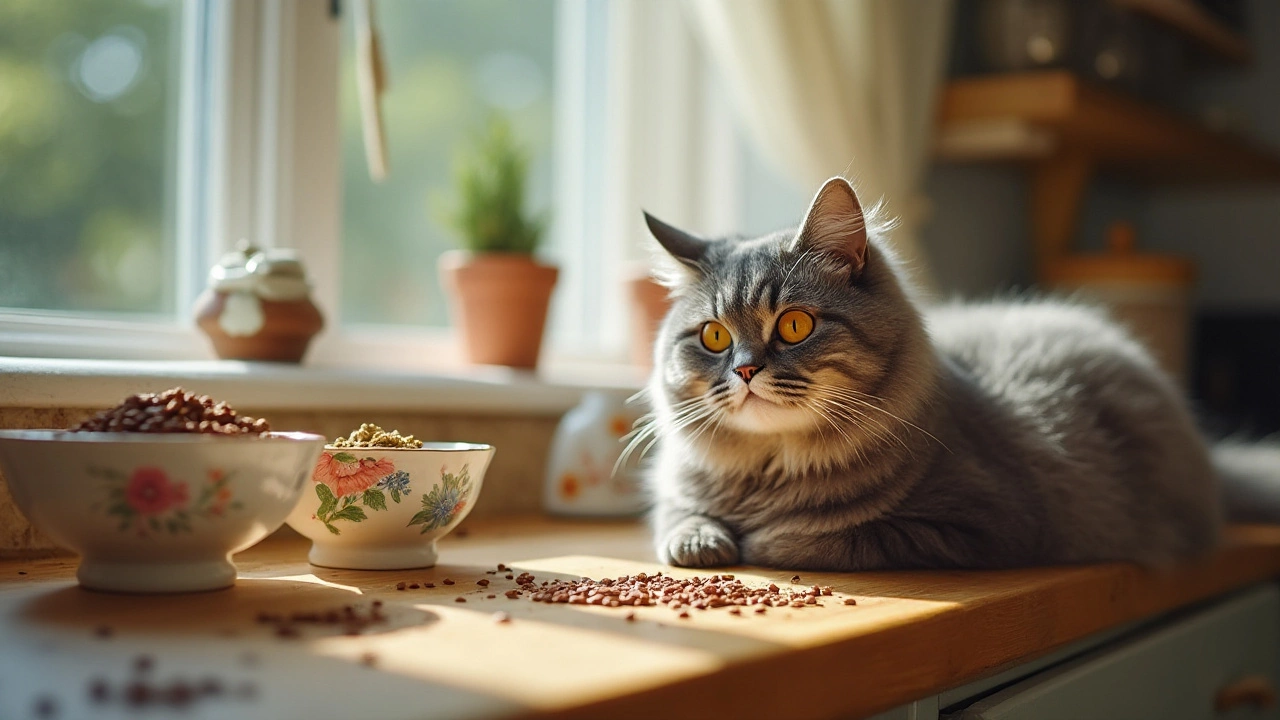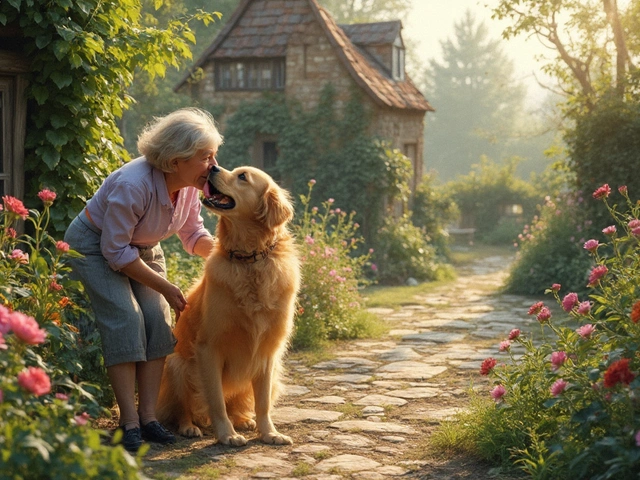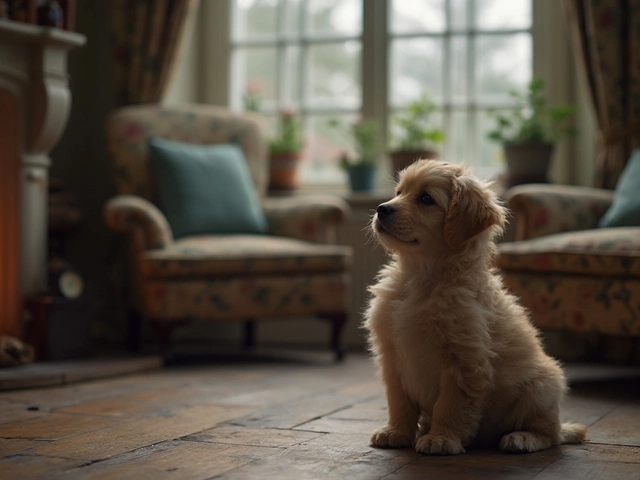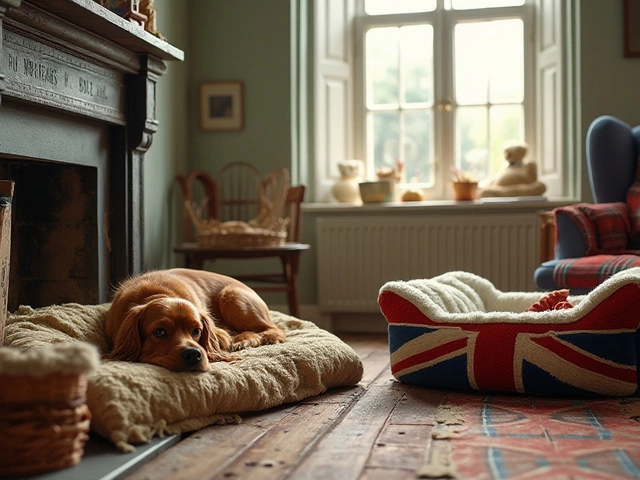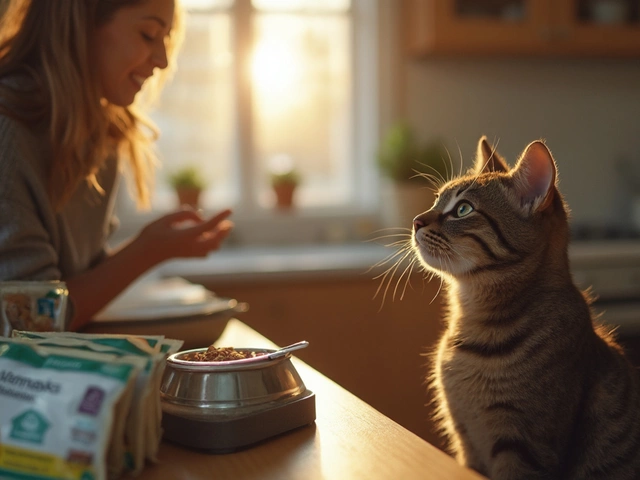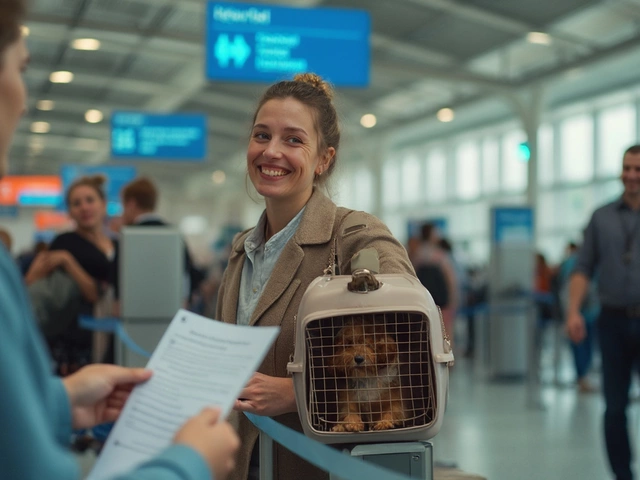Feeding our feline companions isn't just about filling a bowl; it's about understanding their unique needs and behaviors. The choice between scheduled meals and free-feeding dry cat food all day often sparks debates among cat owners.
While some cat parents swear by the convenience of leaving kibble out, others raise concerns about potential health risks or behavioral changes. As we navigate this topic, we'll explore various factors that may influence your decision, including your cat's lifestyle, health condition, and personal preferences.
Whether you're a first-time cat owner or a seasoned feline fanatic, considering the pros and cons of different feeding practices can help you find the best routine for your furry friend. Let's dive into what works best for you and your whiskered companion.
- Understanding Feline Dietary Needs
- Pros of Free-Feeding Dry Cat Food
- Cons of Leaving Dry Food Out
- Impact on Cat Behavior and Health
- Tips for Effective Dry Food Management
- Balancing a Cat's Diet with Other Options
Understanding Feline Dietary Needs
Cats, as creatures of habit and nature, have evolved with specific dietary requirements that reflect their origins as obligate carnivores. This means that they need a diet high in animal protein, moderate in fat, and low in carbohydrates. Their bodies are designed to thrive on meals primarily made up of meat, reflecting the diet they would naturally have in the wild.
Their metabolism hinges on a steady intake of protein, as they are unable to synthesize essential amino acids like taurine from plant matter. Taurine is crucial for heart and eye health, highlighting how a balanced diet with rich proteins is paramount for cats. The absence of sufficient taurine can lead to severe health issues, such as heart disease and vision impairment, which underscores why this should never be overlooked in their nutrition.
In domestic settings, many cat owners rely on both wet and dry food to meet these needs. However, while dry cat food is convenient and less messy, it often contains fillers that do not align with a cat's natural diet. The debate is often about finding a harmony between what is easy for humans and what is healthy for cats. According to nutritionists, it is estimated that cats should consume around two-thirds of their calories from meat proteins to maintain optimal health. Adjusting kibble-based meals to these standards can be challenging, yet not impossible.
The Natural Instincts of Cats
Understanding a cat's dietary needs is also about recognizing their natural behaviors. Cats in the wild tend to eat small, frequent meals throughout the day. This instinct evokes a preference for free-feeding dry food, as it allows them to graze and mimic their hunting routine. However, simply leaving cat food out isn't always the best answer, particularly if the food quality does not match their necessary nutritional profile.
Dr. Jane Robertson, a veterinary nutritionist, once stated, "Meeting a cat’s dietary needs isn’t just about convenience; it’s about ensuring the meals align with what a cat would choose in the wild."
Because every cat is an individual, their dietary requirements can vary significantly. Factors such as age, breed, activity level, and health issues like diabetes or kidney disease play influential roles in determining the best feeding strategy. For instance, kittens have higher caloric needs to facilitate growth and may benefit from more frequent meals. Meanwhile, senior cats often require adjustments to support aging joints and organs.
A comprehensive understanding of feline dietary needs calls for owners to stay informed of current nutritional guidelines and practices. Regular consultations with veterinarians help tailor a specific and effective diet plan that aligns closely with the cat's health demands. After all, a careful balance of nutrition and lifestyle in a cat's diet not only promotes longevity but also ensures the happiness of these unique companions.
Pros of Free-Feeding Dry Cat Food
Keeping dry cat food available at all times for our furry friends can offer several advantages that resonate well with both the cat and the owner. One of the primary benefits is convenience. For pet owners living a busy lifestyle, being able to put out food just once a day rather than managing a strict feeding schedule can significantly streamline daily routines. Cats, being naturally grazers, often prefer to eat small meals throughout the day. This practice mirrors how cats in the wild hunt and eat, which is frequently not in a single large meal but across many smaller ones, thus aligning more closely with their natural instincts.
Free-feeding also minimizes stress associated with meal times. In a multi-cat household, where sorting out pecking order can become an issue, offering free-access to dry food often reduces aggression over food bowls. When food is abundant and accessible, cats are less likely to feel the pressure to fight over food, resulting in a more harmonious environment. Additionally, for cats that are prone to digestive issues like sensitive stomachs, nibbling on smaller portions throughout the day rather than having one large meal can help mitigate these problems. A consistent supply of nutrients helps to maintain their energy levels and can even improve their mood.
"Cats have adapted to take their nutrition in multiple small prey meals rather than two or three larger ones," says Dr. Jane Brunt, executive director of the CATalyst Council. "Having food available can support this natural feeding behavior."
Moreover, dry cat food itself offers its own protective benefits. The crunchy texture assists in maintaining dental health by reducing plaque build-up, a natural advantage over wet foods that lack this quality. Dry foods also usually have a much longer shelf life once opened compared to wet food, which spoils quickly after opening. This means less waste and fewer trips to the pet store, making it a cost-effective and practical solution for many families.
Importantly, a complete and balanced dry food can ensure that your cat receives all the necessary nutrients without the need for additional supplements. Owners often find that cats with continuous access to food are less likely to start improper eating habits, such as food scarfing and subsequent regurgitation, which can occur when a cat feels ravenously hungry between meals or possesses a competitive streak during feeding time. By potentially lowering the stakes at the food bowl, free-feeding offers not only convenience but enriches the overall dietary experience of our feline pals.
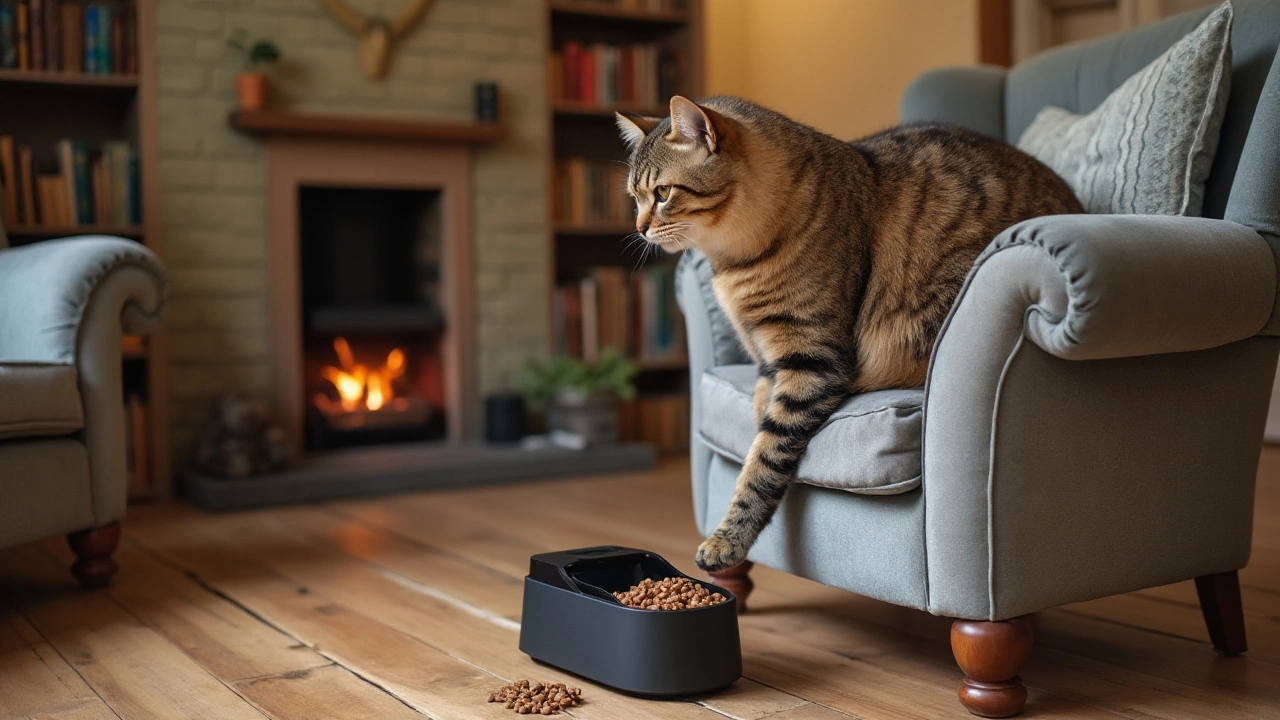
Cons of Leaving Dry Food Out
Keeping dry cat food accessible all the time can seem like a convenient way to make sure your feline friend never goes hungry. However, there are several downsides to this approach that might not be obvious at first glance. One major issue is the potential for overeating, which can lead to obesity, a growing concern among pet health professionals. Cats, like humans, have different metabolisms and some may not have the self-control to stop when they're full. If left unchecked, constant grazing on cat food can result in weight gain, which could then lead to various health issues like diabetes or joint problems.
Another concern is the freshness of the food. Once it's left out for extended periods, dry cat food can become stale, lose its aroma, and sometimes even its nutrients. It's not uncommon for dry food to become unappetizing, making it less likely that your cat will consume what they need. More importantly, humid environments can encourage the growth of mold or bacteria, which poses a significant risk to your cat's health. Have you ever noticed your cat turning their nose up at day-old kibble? It's likely they can sense when food is past its prime.
Another aspect is the impact on your cat's natural feeding habits. In the wild, cats are used to eating multiple small meals a day, often based on when they manage to catch their prey. Limiting their food to specific meal times can keep their instincts sharper and entertain their natural hunting instincts. This is something that free-feeding can dull over time, potentially leading to boredom or behavioral issues. It's like giving a child unlimited access to candy – at first, it seems like paradise, but the long-term effects can be quite negative.
"Cats are obligate carnivores, and their dietary needs are significantly different from dogs or humans," says Dr. Jane Smith, a renowned veterinary nutritionist. "Leaving food out all day can disrupt their natural feeding patterns and ultimately affect their health."
Notably, there are also behavioral implications tied to constantly available food. Cats might become indifferent to mealtime and less appreciative of their meals, potentially even becoming picky eaters over time. Some cats might develop habits like 'meal-guarding' where they become anxious or aggressive about their food being left all the time for consumption, leading to increased stress around feeding areas. This stress can further lead to digestive issues and deepen the cycle of overeating.
If your household has multiple cats, another issue that might arise is the difficulty in monitoring each cat's intake. Cats have different nutritional needs, and some might monopolize the food, leaving others with less than they require. This can result in weight discrepancies among your cats, contributing to some being overfed while others undernourished. This situation might not just lead to health issues for your cats but also create tension between household pets.
Impact on Cat Behavior and Health
Observing how your cat behaves and thrives is a window into understanding the impact of leaving dry cat food out all day. Cats, being natural grazers, might enjoy nibbling throughout the day, aligning with their instinctual habits. This free-feeding approach can promote a sense of autonomy in cats, allowing them to make decisions about when and how much to eat. It's an interesting perspective that acknowledges their self-regulating nature, where they tend to eat when hungry and stop when full. However, this system doesn't cater to all cats. Some may indulge beyond nutritional needs, leading to weight gain. Cats like Maine Coons and other larger breeds might be more prone to overeat due to their impressive appetites.
On the health front, constantly accessible dry cat food could also impact dental health, positioning itself as both a boon and a bane. The hard texture of kibble can aid in scraping off plaque, promoting cleaner teeth. Yet, like with many aspects of health, balance is the watchword. Pet care experts often raise caution around dry kibble potentially lacking moisture which cats intrinsically require. Cats aren't keen on drinking water, a behavior inherited from their desert-dwelling ancestors, which increases their reliance on food for hydration. This hydration challenge becomes more pronounced if you consider that many cats don't consume enough water daily, thus posing the risk of urinary tract infections or kidney issues. A study revealed some interesting data on cat hydration linked to diet, as illustrated below:
| Type of Cat Food | Average Water Intake | Associated Health Impacts |
|---|---|---|
| Wet Food | 70% Water Content | Better Hydration |
| Dry Food | 10% Water Content | Potential Dehydration |
Behaviorally, free-feeding might lead to food guarding, a less noticeable issue that stands the risk of escalating with multi-cat homes. Cats, being territorial, could develop possessiveness over the food left lying around, sparking unwanted aggression or anxiety. According to Dr. Jane Brunt, Executive Director of the CATalyst Council,
"While cats can be finicky eaters, when they sense competition, even the pickiest cat can become protective over their meals, which may lead to stress-related behaviors."Consider these factors carefully, for the nuances of feline well-being unfold in intricate patterns, each as unique as the individual cat. Engaging with your cat on this level turns feeding from a task to a shared chapter in your journey together.

Tips for Effective Dry Food Management
Leaving dry cat food available all day can be a sensible option, but it's essential to manage it effectively to ensure your cat stays healthy and happy. Managing dry cat food isn't about just pouring it into a bowl and walking away—there are several aspects to consider that can help your feline friend get the right nutrition and maintain a healthy lifestyle. One important factor is controlling portion sizes. Although free-feeding suggests unlimited access, it doesn't mean excessive consumption should be allowed. Monitoring how much your cat eats can prevent obesity, which is a common issue among house cats. Consider using a measuring cup to dispense a daily amount that suits your cat's age, weight, and activity level.
Another key tip involves maintaining the quality of the food itself. Over time, dry cat food can lose its appeal or nutritional value if not stored correctly. A sturdy, airtight container can keep kibble fresh by preventing exposure to moisture and pests. This simple step can make a big difference, as fresh kibble retains taste and nutritional benefits. Make sure to place the storage container in a cool, dry place, avoiding direct sunlight which can break down the food's essential fats and vitamins.
It's also crucial to observe your cat's behavior and eating habits regularly. This means keeping an eye on how much they eat and whether there are any changes in their appetite. Any significant changes could be a signal of health issues that might require attention. Establishing a routine where you check on their food intake daily can help you catch any potential problems early. It's wise to keep a food diary to track these patterns over time.
A balanced diet is another consideration for effective management. Too much reliance on dry cat food could mean your cat isn't getting enough moisture in their diet. Although dry kibble is convenient, supplementing it with wet food or a hydrating treat can ensure your pet gets the necessary hydration. This is especially important for male cats prone to urinary tract issues. Some owners choose to introduce limited wet food meals in their feeding schedule to balance things out.
Lastly, cleanliness around your cat's feeding area is vital. Regularly wash their food bowls and clean around their feeding area to prevent bacteria build-up that could lead to health problems. A dedicated feeding mat can help contain any mess and make clean-up easier. By combining these practices, you'll promote not just good habits but also a healthier environment for your cat.
"Pet owners should pay attention to dietary variety and ensure their cats are obtaining a well-rounded array of nutrients.” - Dr. Alice Bennett, Feline Nutritionist
Balancing a Cat's Diet with Other Options
When it comes to a feline's nutrition, striking the right balance is crucial. Cats are obligate carnivores, which means their diet should consist primarily of meat. While dry cat food offers convenience and is often enriched with essential nutrients, it may lack the moisture that our feline friends need for optimal health. Ensuring your cat receives a diet that mimics what they would find in the wild can improve their overall well-being. Mix in a variety of food textures and moisture levels to cater to their dietary requirements.
One strategy is to combine dry kibble with wet food. Wet food not only provides your cat with essential hydration but also entices them with its flavor and texture variety. Offering a mix helps stimulate their interest in meals and keeps them from getting bored with dry cat food alone. To create a balanced diet, measure out appropriate portions of both types of food based on their lifestyle, age, and weight. Remember to consult your veterinarian to tailor the diet specifically to your cat's needs.
It is equally important to pay attention to your cat's individual preferences and digestive responses. Some might not tolerate certain ingredients well, while others may exhibit signs of food allergies. By keeping a close watch on their behavior and any changes in their health, you can adjust their diet accordingly. Adding a probiotic supplement could also aid digestion and keep their gastrointestinal tract healthy.
Providing your cat with occasional fresh treats can enhance their diet further. Offer small quantities of cooked meat or fish, ensuring you avoid seasonings and bones. These treats can give your cat an additional protein boost and a joyful dining experience. However, always monitor treat portions to prevent unintentional weight gain.
Additionally, access to clean water is a necessity, especially when including dry cat food in their diet. Hydration is critical as it supports kidney function, particularly in older cats. Investing in a cat water fountain might encourage your cat to drink more by providing a constant, interesting water source. Many cats prefer running water, so these fountains can significantly increase their water intake.
Lastly, evaluate the food's quality by checking its ingredients. Look for cat food brands that include high levels of animal proteins and minimal fillers. Avoid artificial preservatives, colors, and flavors that offer no nutritional benefit. Transparency in sourcing and manufacturing processes is a good indicator of a reputable brand. A well-balanced, high-quality diet helps maintain your cat's health and vitality throughout their life.

